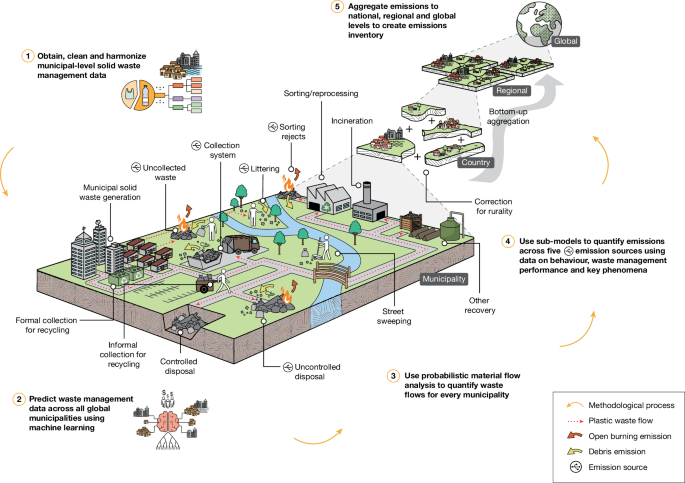A Comprehensive Global Inventory of Macroplastic Pollution Sources and Emission Hotspots
Основные понятия
A comprehensive global inventory of macroplastic pollution sources and emission hotspots, identifying key drivers and informing policy actions to address the plastic pollution crisis.
Аннотация
This study presents a detailed global inventory of macroplastic pollution emissions, combining conceptual modeling of emission mechanisms with measurable activity data. The key insights are:
The researchers estimate global plastic waste emissions at 52.1 [48.3–56.3] million metric tonnes (Mt) per year, with approximately 57% wt. from open burning and 43% wt. from unburned debris.
Littering is the largest emission source in the Global North, while uncollected waste is the dominant source across the Global South.
The study identifies emission hotspots across 50,702 municipalities worldwide, using machine learning and probabilistic material flow analysis. This high-resolution baseline can help inform treaty negotiations and develop national/sub-national waste management action plans.
The findings suggest that addressing plastic pollution will require a multi-pronged approach targeting both littering and uncollected waste, with tailored solutions for different regions and contexts.
The comprehensive inventory provides a crucial foundation for policymakers and stakeholders to identify priority areas, allocate resources, and implement effective interventions to mitigate the global plastic pollution crisis.
A local-to-global emissions inventory of macroplastic pollution - Nature
Статистика
The study estimates global plastic waste emissions at 52.1 [48.3–56.3] million metric tonnes (Mt) per year.
Approximately 57% wt. of the emissions are from open burning, and 43% wt. are from unburned debris.
Цитаты
"Littering is the largest emission source in the Global North, whereas uncollected waste is the dominant emissions source across the Global South."
"We suggest that our findings can help inform treaty negotiations and develop national and sub-national waste management action plans and source inventories."
Ключевые выводы из
by Joshua W. Co... в www.nature.com 09-04-2024
https://www.nature.com/articles/s41586-024-07758-6
Дополнительные вопросы
How can the high-resolution emission hotspot data be leveraged to target interventions and drive behavioral change at the local community level?
The high-resolution emission hotspot data can serve as a critical tool for local communities to identify specific areas where macroplastic pollution is most prevalent. By pinpointing these hotspots, stakeholders can design targeted interventions that address the unique challenges faced by each municipality. For instance, communities can implement localized waste management strategies, such as enhanced litter collection programs or educational campaigns focused on reducing littering behaviors, particularly in areas identified as significant emission sources.
Moreover, this data can facilitate community engagement by providing residents with clear, actionable information about their local plastic pollution issues. By visualizing the data through maps and infographics, communities can foster a sense of ownership and responsibility towards their environment. This can drive behavioral change, encouraging residents to participate in clean-up initiatives, adopt sustainable practices, and advocate for better waste management policies. Additionally, local governments can use this data to prioritize funding and resources for waste management infrastructure improvements, ensuring that interventions are both effective and sustainable.
What are the potential unintended consequences or trade-offs of focusing solely on reducing open burning versus uncollected waste as emission sources?
Focusing solely on reducing open burning as an emission source may lead to unintended consequences, particularly if it diverts attention and resources away from addressing uncollected waste, which is a significant issue in many regions, especially in the Global South. For instance, if communities implement strict regulations against open burning without simultaneously improving waste collection systems, they may inadvertently exacerbate the problem of uncollected waste. This could lead to increased littering or illegal dumping, as residents seek alternative disposal methods for their waste.
Additionally, prioritizing open burning reduction might result in the increased use of landfills or incineration, which can have their own environmental impacts, such as greenhouse gas emissions and leachate contamination. Therefore, a balanced approach that addresses both open burning and uncollected waste is essential. This includes investing in comprehensive waste management systems that encompass waste reduction, recycling, and proper disposal methods, ensuring that efforts to mitigate one source of emissions do not create new environmental challenges.
What role can emerging technologies, such as advanced waste sorting and recycling systems, play in addressing the root causes of macroplastic pollution across different regions and contexts?
Emerging technologies, such as advanced waste sorting and recycling systems, can play a transformative role in addressing the root causes of macroplastic pollution by enhancing the efficiency and effectiveness of waste management practices. These technologies can improve the separation of recyclable materials from general waste, thereby increasing recycling rates and reducing the volume of plastic that ends up in unmanaged environments.
For instance, automated sorting systems equipped with artificial intelligence can accurately identify and separate different types of plastics, ensuring that more materials are diverted from landfills and incineration. This not only reduces plastic emissions but also promotes a circular economy where materials are reused and repurposed. Additionally, innovations in recycling technologies, such as chemical recycling, can enable the processing of contaminated plastics that are typically non-recyclable, further mitigating plastic waste.
In different regional contexts, these technologies can be tailored to meet specific local needs. For example, in areas with limited infrastructure, mobile recycling units can be deployed to facilitate waste collection and processing. In urban settings, smart waste bins equipped with sensors can optimize collection routes and schedules, reducing operational costs and emissions associated with waste transport. Overall, leveraging emerging technologies can significantly enhance waste management systems, reduce macroplastic pollution, and contribute to sustainable environmental practices globally.
0
